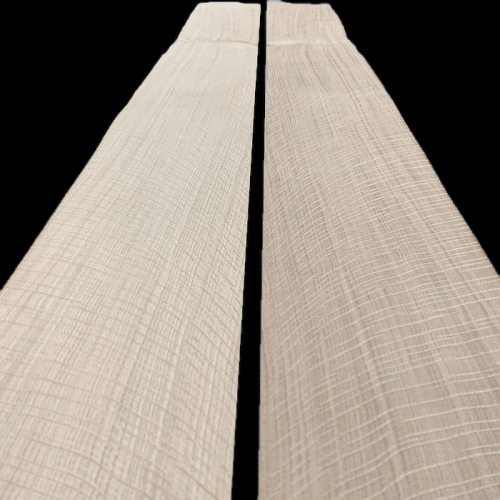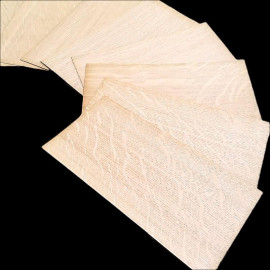
Flaky Oak Veneers 210 x 17 cm
Flaky Oak Veneers 210 x 17 cm
Genuine wood sliced-veneer sheets, in sequence.
Length: 210 cm.
Width: 17 cm.
Thickness: 0.6 mm.
Sold by the sheet.
These photos are taken from the veneer sheets you will receive.
Flaky Oak Veneers 210 x 17 cm
Genuine wood sliced-veneer sheets, in sequence.
Dimensions:
Length: 210 cm.
Width: 17 cm.
Thickness: 0.6 mm.
Measurement scaling:
The width is rounded to the covered centimeter. For example, 15.8 cm is given 15 cm.
The length is rounded to 5 centimeters. For example, 257 cm is given 255 cm.
Pictures:
Pictures herewith are actual photos of the product you will receive.
Species:
Common Names:
Oak, Common Oak, Pedunculate Oak.
Note:
In France, it is considered the quintessential noble wood. It is the sacred tree of the Druids and also the tree under which Saint Louis dispensed justice.
It is particularly prevalent in state-owned forests, whose organization and silviculture are due to Colbert, Minister of Louis XIV. Colbert desired a powerful navy and, therefore, numerous and well-organized oak forests for sustainable renewal. However, Colbert could not foresee that 250 years later, when the trees would reach maturity, warships would no longer be made of wood.
Oak is a highly tannic wood. The Gaulish word for oak was "tann," from which we derive words like "tanner," "tanner," and "tannin." Oak tannins have been used since antiquity to tan leather. It is also what develops woody flavors in wine and deepens its red color.
Botanical Name:
Quercus petraea and Quercus robur.
Origin:
Generally, oak can be found throughout the Northern Hemisphere.
In France, the common oak and the pedunculate oak are the main species that make up the northern French oak forests. More rarely, one can find a sessile oak, but this remains anecdotal.
In southern France, the evergreen oak and the cork oak are emblematic.
Appearance:
Oak is a hard texture wood with large pores. Recognizable by its fine and discreet grain on the flat-sawn surface, it is more present, even omnipresent, on the quarter-sawn surface.
Its raw color is generally a sandy blonde. However, it varies depending on the soil (siliceous or calcareous) and the type of plantation (high forest or coppice).
Among the different appearances of oak, the most iconic are:
Brown oak: Generally, brown is an upward coloration of the base of the oak when the tree becomes old, a bit like human hair that turns gray/white. Like some humans, certain trees become completely brown, sometimes even in early adulthood, except for the sapwood, which remains white.
Smoked oak: This is an oak whose tannin has been reacted to give it a color ranging from milky coffee brown to charcoal black.
Swamp oak: These are oaks that fell into a swamp several thousand years ago. They are generally discovered during agricultural earthworks.
These oaks are in the process of fossilization. They have a very particular charcoal gray hue, and of course, they are very rare.
Flaky oak: The flake is the oak's medullary rays, in other words, its "skeleton." When you cut a plank or a veneer on the quarter, you find yourself parallel to the medullary rays, and as a result, the flake is very visible and creates particularly aesthetic patterns.
Other specialties are oak burl, oak crotch, and knoty oak... will complete this non-exhaustive list.
Properties:
Weight: approximately 675 kg/m³ at 10-12% moisture content
Janka hardness: 4980 Newton, for comparison: ash is 6580 N and poplar is 1650 N
Elasticity: 10.60 Gigapascals, for comparison: US maple is 12.62 GPa and poplar is 9.75 GPa.
Tensile strength: 97 Megapascals, for comparison: US maple is 109 MPa and poplar is 62 MPa.
Uses:
Oak is a wood that combines strengths, like a decathlon athlete who is not the best in any discipline but is strong in several.
Thanks to its qualities, oak is used in many areas:
Construction: Oak is used to construct frames, floors, exterior joinery (doors, windows), and decorative elements (paneling, moldings).
Furniture: Oak is a highly prized wood for manufacturing quality furniture, such as tables, chairs, wardrobes and chests of drawers.
Flooring: Oak flooring is very resistant and aesthetic. It is often chosen for quality floors.
Cooperage: Oak is used to make aging barrels for wines and spirits.
Other uses: Oak is used to manufacture tools, decorative objects, and boats.
Product Description:
Genuine wood-sliced veneer sheets.
These veneers are raw without a finish or any fleece back.
The veneer surface is similar to plane wood. However, it will be preferable to forecast a light sanding after gluing.
The veneers are offered here as wood-sliced sheets of one and unique thickness.
Both faces of these veneers are the same, without fleece back, without glue.
Even if the veneer's sides had been cut relatively straight, it isn't a precise parallel clipping; some veneers may have kept the decreasing shape of the tree, wider at the bottom end and narrower at the top end.
Very occasionally, some veneers' sides have traces of unclipped wane, but our veneers are measured at the narrowest, as explained in the paragraph "sizes."
As genuine natural wood, all finishing products are acceptable as long as they are meant for wood use.
The choice of the finished product must be consistent with the final usage realization.
Use of the veneers:
Cutting:
Veneers can be easily cut with a utility knife.
For straight cuts, the best results are obtained with a veneer saw.
Use a fretsaw, scalpel, or veneer knife for curved cuts.
Always allow for a slightly larger veneer sheet than your intended surface. This will allow you to adjust the size after gluing for a clean finish.
A flush trimmer can also be used to trim the veneer after gluing.
When cutting with a utility knife or veneer knife, it is best to cut with the grain of the wood. To check this, run your finger along the edge of the sheet. The direction that feels smoothest is the ideal direction for cutting.
Gluing:
Several types of gluing are possible.
- With vinylic glue, the veneer is pressed over its entire surface.
- With neoprene glue for all surfaces, especially non-porous surfaces, by applying two coats of glue and marouflage.
With animal glue such as hide, sinew, or bone glue.
With vinyl glue and an iron, apply two thin coats of glue to each piece. This technique should only be used if other gluing techniques are not possible.
Sanding:
Veneers and all our products are wood and can be sanded according to their thickness.
Do not use a belt sander regardless of the thickness of the veneer, as this could pierce it.
With a 0.6 mm veneer, lightly sand with 120 grit and then finish with 180 or 240 grit. With an orbital sander, 180 grit is already sufficient for most applications.
Finishing:
All finishing products generally used for wood are suitable for finishing our products. For example, you can use a varnish, wax, paint, or oil.
However, ensure that the product you want to use is compatible with the final use of your creation.
More information:
Please look at our TUTORIALS; you might find some valuable tips.
Please contact us by email or phone for any additional information.
You might also like
 English
English






